Monitoring Optical Line Terminal ONTs with Flask and SNMP
 Hemant Chimulkar
Hemant ChimulkarIntroduction
In the dynamic realm of telecommunications network management, real-time data and seamless integration are paramount. I've developed a cutting-edge web application that provides comprehensive management of Optical Line Terminal (OLT) devices, their Optical Network Terminals (ONTs), and Passive Optical Network (PON) ports. This solution combines Flask for web application and API functionality, WebSockets for real-time data streaming, and SNMP for device communication. The result is a powerful tool offering detailed diagnostics, live performance monitoring, and seamless integration with ticketing systems, regardless of the OLT brand.
Key Features
Brand-Agnostic OLT Management: Monitor and manage ONTs and PON ports across various OLT brands.
Real-Time ONT Traffic Monitoring: Utilize WebSockets to display live traffic data for individual ONTs.
Historical Traffic Analysis: Access and analyze historical traffic data for trend identification.
ONT Status Tracking: Check the status of individual ONTs connected to the OLT.
PON Port Optical Power Monitoring: Monitor optical power levels of PON ports to identify potential issues.
Automated Ticket Generation API: Expose Flask endpoints for raising tickets automatically when issues are detected.
SNMP Integration: Utilize SNMP for efficient data collection and device management.
SQL Database Storage: Store collected data in an SQL database for historical analysis and reporting.
ONT Management: Add and delete ONTs directly through the interface.
PON Port Control: Shut down and restart PON ports as needed.
Downtime Diagnostics: Identify and display the cause of ONT and PON port downtimes.
Technical Implementation
Flask Web Application and API
The core of this project is a Flask application serving dual purposes:
A web interface for monitoring, management, and diagnostics.
An API for automated ticket raising and integration with other systems.
WebSocket Integration for Real-Time Monitoring
WebSockets are employed to provide real-time updates on ONT traffic data:
Establish persistent, full-duplex connections between the server and clients.
Push live traffic data as soon as it's available.
Enable real-time updates without page refreshes.
Reduce server load by eliminating the need for frequent polling.
SNMP Integration
Simple Network Management Protocol (SNMP) is used for data collection, device management, and retrieving diagnostic information.
Database Management
An SQL database stores all collected data, configuration changes, and diagnostic information, enabling comprehensive data analysis and reporting.
Automated Ticket Generation API
The application exposes RESTful API endpoints for ticket generation, allowing for integration with various ticketing systems.
Advanced Management and Diagnostic Features
Real-Time ONT Traffic Monitoring
Live streaming of traffic data for each ONT using WebSockets.
Dynamic updating of charts and graphs without page reloads.
Immediate visibility of traffic spikes or anomalies.
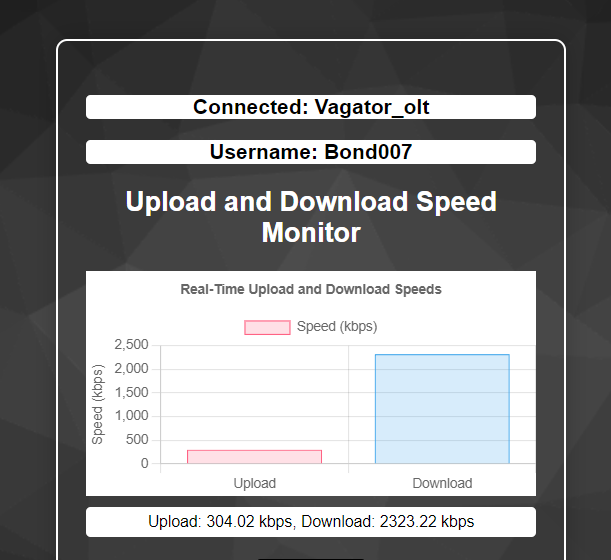
Historical Traffic Analysis
Access to stored traffic data for trend analysis and capacity planning.
Customizable date ranges for historical data viewing.
ONT Provisioning and Monitoring
Add new ONTs to the OLT.
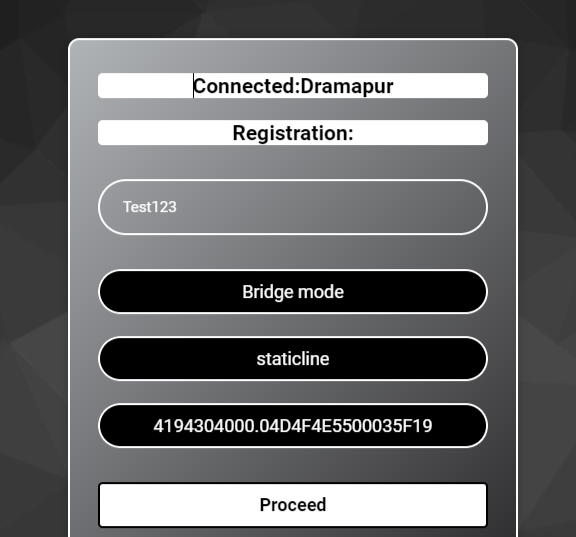
Delete existing ONTs from the OLT.
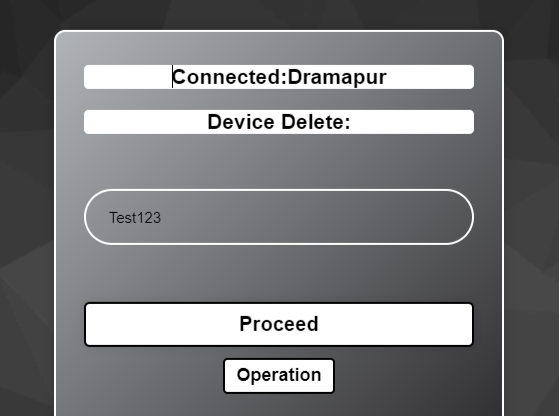
Show the cause of ONT downtime when it occurs.
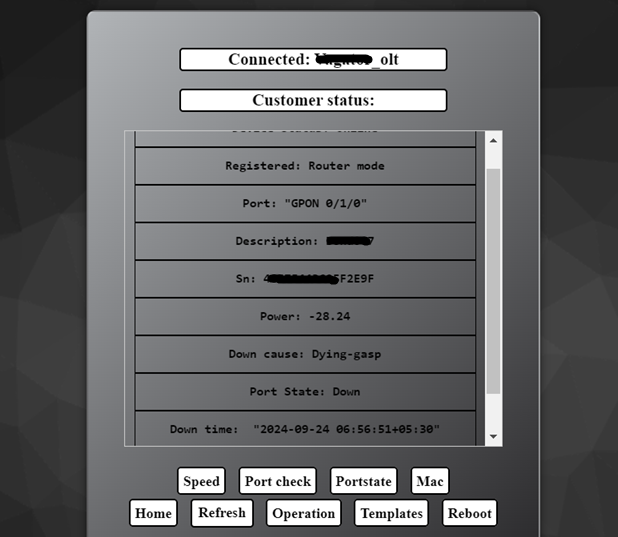
PON Port Control and Diagnostics
Shut down PON ports for maintenance or security reasons.
Restart PON ports after maintenance or to resolve issues.
Display the cause of PON port downtimes.
Detailed Downtime Analytics
Capture and display specific causes of downtimes for PON ports.
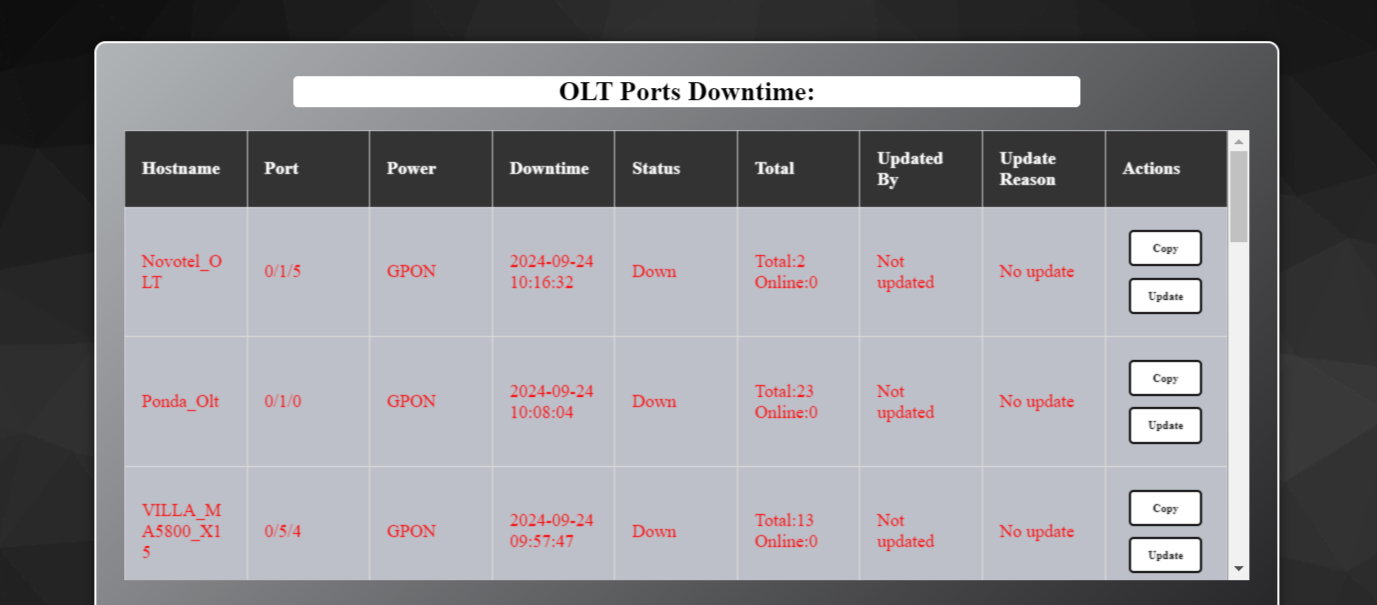
API for Automated Ticket Raising
The Flask-based API for ticket raising offers:
Seamless integration with existing ticketing systems.
Customizable ticket creation based on issue type and severity.
Inclusion of rich diagnostic data in ticket descriptions.
Trigger-based ticketing for proactive issue management.
Benefits and Use Cases
This comprehensive OLT management solution offers numerous benefits:
Real-Time Visibility: Instant access to live ONT traffic data for immediate decision-making.
Proactive Network Management: Quickly identify and respond to traffic anomalies or issues.
Enhanced User Experience: Smooth, dynamic updates to the monitoring interface without disruptions.
Unified Management Interface: Monitor, control, and diagnose OLTs from different vendors in a single interface.
Automated Issue Reporting: Streamline the process of identifying issues and creating detailed trouble tickets.
Improved Response Time: Faster issue detection and ticket creation lead to quicker problem resolution.
Deep Diagnostic Insights: Quickly identify the root causes of network issues.
Operational Efficiency: Automate routine tasks and streamline ONT and PON port management.
Data-Driven Decision Making: Use real-time and historical data to inform network upgrades and maintenance strategies.
System Integration: Easy integration with existing network management ecosystems through the API.
Docker Containerization
The entire application is containerized using Docker, providing several benefits:
Consistency: Ensures the application runs the same way in every environment.
Portability: Easily deploy the application on any system that supports Docker.
Scalability: Simplifies the process of scaling the application horizontally.
Isolation: Keeps the application and its dependencies separated from the host system.
Version Control: Allows for easy management of different versions of the application.
Rapid Deployment: Enables quick and easy deployment and updates.
The Docker setup includes:
A Dockerfile defining the application environment.
Docker Compose configuration for orchestrating multiple containers (e.g., the app, database, and any additional services).
Environment variable management for flexible configuration across different deployments.
Future Enhancements
Potential future enhancements include:
Advanced Real-Time Analytics: Implement AI-driven analysis of live traffic data for instant anomaly detection.
Predictive Maintenance: Use machine learning on real-time and historical data to predict potential failures before they occur.
Expanded WebSocket Capabilities: Extend real-time updates to other aspects of the system beyond ONT traffic.
Interactive Real-Time Visualizations: Develop more sophisticated, interactive charts and graphs for live data representation.
Custom SNMP Profiles: Allow users to create and share SNMP profiles for different OLT brands and models.
Bulk Operations: Enable bulk addition/deletion of ONTs and control of multiple PON ports simultaneously.
Automated Recommendations: Provide real-time suggestions for optimizing network performance based on current traffic patterns.
Container Orchestration: Implement Kubernetes for advanced container orchestration and automatic scaling based on load.
Conclusion
This advanced OLT management tool, leveraging Flask, WebSockets, and SNMP, represents a significant leap forward in network operations and real-time monitoring. By combining comprehensive OLT management capabilities with live data streaming and a flexible API for ticket raising, we've created a versatile solution that enhances network visibility, improves operational efficiency, and seamlessly integrates with existing systems.
For network operators seeking to optimize their multi-vendor OLT operations or developers aiming to create sophisticated, integrated telecommunications management applications with real-time capabilities, this project serves as an exemplary model. It adapts to diverse network environments while providing advanced management features, crucial diagnostic capabilities, live monitoring, and seamless integration options, ultimately leading to more reliable, efficient, and responsive network operations.
Subscribe to my newsletter
Read articles from Hemant Chimulkar directly inside your inbox. Subscribe to the newsletter, and don't miss out.
Written by
